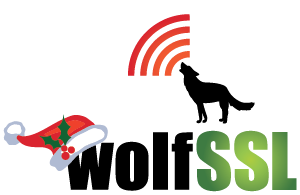The sniffer support for processing multiple streams concurrently using our asynchronous version of the library. Support has been added for offloading to Intel QuickAssist or Cavium Nitrox V type hardware. Additionally we support offloading to worker threads. This allows a large increase in sniffer throughput for handling the asymmetric operations. Our sniffer tool is built […]
Read MoreMore TagCategory: Uncategorized
wolfSSL Pack updates for STM Cube and Keil MDK
We offer two CMSIS packs for wolfSSL to assist with quick adoption of our library into your projects. Our STM Cube Pack For STM32 users we offer a CMSIS pack. This is available inside the STM32CubeIDE as we are a “MadeForSTM32” project. We work closely with STM to provide a seamless integration. The integration provides […]
Read MoreMore TagCAAM+QNX+i.MX8
CAAM support with wolfSSL on QNX was expanded. Previously the port included i.MX6 devices now it can run on i.MX8 devices and handle AES-CTR operations in addition to the previously supported ECC, CMAC, and BLOB operations.This enhancement included some additional refactoring and robustness of the QNX resource manager in wolfSSL. If you have any questions […]
Read MoreMore TagwolfBoot v1.12 Released
wolfBoot v1.12 has been released. This version introduces the support for a new signature verification algorithm, RSA3072, new test cases, a new simulated architecture to speed up the validation, and some new features to support more use cases. Here is a brief description of some of the new features in this version. Support for encrypted […]
Read MoreMore TagUpcoming Live Webinar : wolfEngine – wolfCrypt as an Engine for OpenSSL
Join our live wolfEngine webinar, where we introduce one of our newest products wolfEngine, a separate standalone library which links against wolfSSL (libwolfssl) and OpenSSL. wolfEngine implements and exposes an OpenSSL engine implementation which wraps the wolfCrypt native API internally. Algorithm support matches that as listed on the wolfCrypt FIPS 140-2 certificate #3389. Learn about […]
Read MoreMore TagwolfMQTT Releases v1.14.0
The summer release of wolfMQTT, v1.14.0, is now available! This release has several bug fixes and optimizations including: Support post-quantum KYBER_LEVEL1 and P256_KYBER_LEVEL1 with FALCON_LEVEL1 in wolfMQTT. by @anhu #300 Add WOLFMQTT_USE_CB_ON_DISCONNECT for CB on client disconnect by @embhorn in #302 Fix to release connect ack props by @embhorn in #301 Check out the changelog […]
Read MoreMore TagDTLS 1.3 Beta Out!
DTLS 1.3 is here! wolfSSL release 5.4.0 was recently sent out and one of the exciting new features in the release was initial support for DTLS 1.3. This new protocol implementation gives improvements over the previous 1.2/1.0 versions of DTLS and compliments the TLS 1.3 implementation in wolfSSL quite nicely. wolfSSL prides itself on our […]
Read MoreMore TagwolfSSL 5.4.0 Release!
DTLS 1.3 is here! wolfSSL release 5.4.0 was recently sent out and one of the exciting new features in the release was initial support for DTLS 1.3. This new protocol implementation gives improvements over the previous 1.2/1.0 versions of DTLS and compliments the TLS 1.3 implementation in wolfSSL quite nicely. Another big change to make […]
Read MoreMore TagNIST Announces Post-Quantum Algorithm Standardization
Well, the internet has been abuzz with the announcement of the four post-quantum algorithms that will move on from the NIST Post-Quantum Competition to standardization. They are: KYBER Key Encapsulation Mechanism DILITHIUM Signature Scheme FALCON Signature Scheme SPHINCS+ Signature Scheme NIST has a very detailed report about the algorithms and some explanations which can be […]
Read MoreMore TagwolfSSH examples for Espressif on ESP32 or ESP8266
At wolfSSL we create solutions to provide secure access to a variety of systems and devices. Our latest example adds the ability to use the SSH protocol to securely connect plain text serial UART using an Espressif ESP32 or ESP8266 over wireless or wired ethernet. In celebration of this new capability, we’re having a contest […]
Read MoreMore Tag
